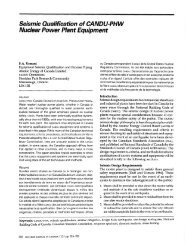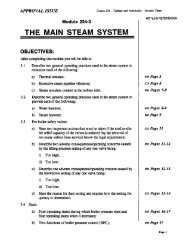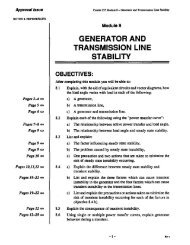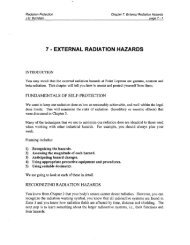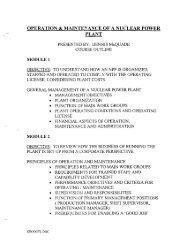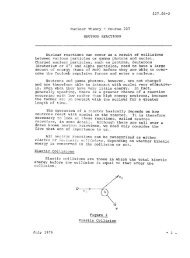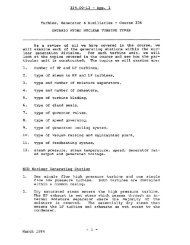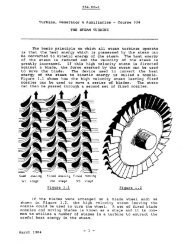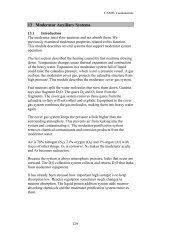Reactor Control Systems of Qinshan Phase III CANDU ... - canteach
Reactor Control Systems of Qinshan Phase III CANDU ... - canteach
Reactor Control Systems of Qinshan Phase III CANDU ... - canteach
You also want an ePaper? Increase the reach of your titles
YUMPU automatically turns print PDFs into web optimized ePapers that Google loves.
provide the operator with a vehicle to display any <strong>of</strong> the PDS displays in a format that<br />
supports viewing by everyone in the control room. The displays are therefore dynamic<br />
and can be selected to maximize the benefit to the operators for the different operating<br />
situations <strong>of</strong> the plant (shutdown/outage through power productions and emergencies). In<br />
addition to the benefits <strong>of</strong> the improved display suite, the use <strong>of</strong> central large screen<br />
displays provides the following benefits:<br />
• Enhanced operator communication and reduced communication errors<br />
• Enhanced human error recovery to permit corrections before the significant<br />
consequences are realized<br />
• Reduced in unplanned outages and enhanced recovery from planned and unplanned<br />
outages<br />
The new <strong>CANDU</strong> 6 control room incorporates an enhanced main VDU-based sit-down<br />
console. Here a single operator can monitor and control normal plant operations from<br />
shutdown to full power, without requiring operation at stand-up panels. The four VDUs<br />
and improved console design and layout provide enhance operator support for:<br />
• Safety system and critical safety parameter monitoring at the console following an<br />
upset, and<br />
• Monitoring and diagnosis <strong>of</strong> plant processes including interrogation <strong>of</strong> annunciation.<br />
The PDS is also designed to support the storage <strong>of</strong> data on-line for 24hrs and the<br />
extraction <strong>of</strong> data to <strong>of</strong>f-line media to support process surveillance and health monitoring.<br />
Conventional <strong>Systems</strong><br />
The control concept provides for conventional technology to control and monitor the<br />
plant during and following design basis events. It provides redundancy and reliability to<br />
plant control when assurance <strong>of</strong> the functioning <strong>of</strong> digital equipment may be difficult or <strong>of</strong><br />
concern. The conventional panels are also used to control and maneuver the individual<br />
systems <strong>of</strong> the plant during shutdown states and portions <strong>of</strong> warm-up and cooldown for<br />
local system alignment. This permits operators to maintain training and familiarization<br />
with the controls algorithms that are designed to be independent <strong>of</strong> each other, to be<br />
immune to single faulty inputs and to do checks on their outputs. These requirements are<br />
met by ensuring that each program reads in all the inputs it requires, then control modules<br />
are designed to be independent <strong>of</strong> each other, to be immune to single faulty inputs and to<br />
do checks on their outputs. These requirements are met by ensuring that each program<br />
reads in all the inputs it requires, the control algorithms are designed to be independent <strong>of</strong><br />
each other, to be immune to single faulty inputs and to do checks on their outputs.<br />
CJNPE_paper990401<br />
11/21/05<br />
14




